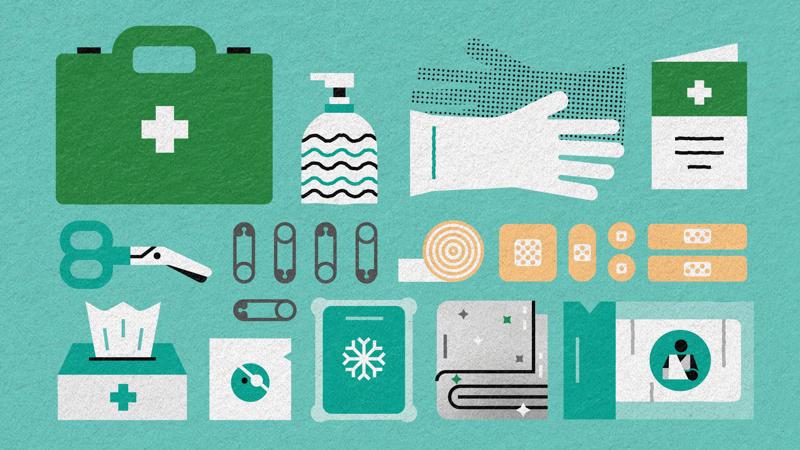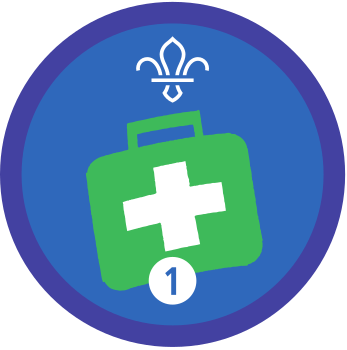
Be an emergency aider: primary survey
You’ll need
- Big pieces of paper
- Pens or pencils
- Sticky tack
- Resuscitation manikins
- Antibacterial wipes
- CPR masks
Before you begin
- Make sure the person leading the activity knows about first aid. Someone from your group or local area with a first aid certificate could take charge, or you could reach out to places that help provide first aid training or support, for example, St John Ambulance or the British Red Cross.
- You’ll need enough leaders for the activity, including enough people who are happy to demonstrate first aid techniques.
- Adults should only demonstrate and practise first aid on other adults; young people should only demonstrate and practise first aid on other young people. Adults and young people should never demonstrate or practise first aid on each other.
- Remember that this activity touches on topics that might be sensitive for some people. Give everyone the opportunity to step away if they need to compose themselves.
- Write ‘DR ABC’ on an A3 piece of paper, with each letter one beneath the other. Stick it on the wall so everyone can see it.
- Make sure you have resuscitation manikins. If someone’s coming along specially to help, they may have some you can borrow. If not, chat to other groups or your District or County and ask if they can help.
Learn the basics
- The person leading the activity should ask if anyone knows what ‘DR ABC’ stands for, and why it’s important. They should explain that it stands for danger, response, airway, breathing, circulation, and write each word next to the letter on the big piece of paper.
- Have a discussion about first aid: why it’s done, how it’s done, what emergency services are available, and where accidents can happen. Also talk about how a first aider should begin by completing a primary survey to assess the situation and attend to the casualty.
- Demonstrate how to complete a primary survey, using another adult as the example casualty. Explain what you’re doing (and why you’re doing it) every step of the way.
- Everyone should get into groups of three. Each group should practise a primary survey. One person should be the casualty, one person should be the first aider, and one person should be the observer who’ll come to help and call 999.
- Once all of the groups have finished, see what everyone knows about the recovery position. When would they use it? Does anyone know the steps?
- Show everyone how to put someone in the recovery position. Remember to demonstrate on another adult, and explain what they’re doing every step of the way.
- Everyone should get into pairs of young people. They should practise putting each other in the recovery position. Get the other leaders to walk around so they can help if anyone’s finding it tricky.
- Finally, get the resuscitation manikins and spread them out around the meeting place.
- Demonstrate how to do CPR using one of the manikins. Remember to explain what you’re doing every step of the way.
- Everyone should split into as many groups as there are CPR manikins.
- Each group should take it in turns to practise CPR on the manikins. They should clean the face and mouth with anti-bacterial wipes between each person practising. Get the other leaders to walk around so they can help if anyone’s finding it tricky.
This information is correct as of June 2020. For the most up-to-date information, check with St John Ambulance. The primary survey’s a quick way to find out how to treat the most serious conditions a casualty might have. It goes in order of priority. The acronym DR ABC helps everyone to remember the steps.
- Danger: Before going near the casualty, make sure the area is safe. Check for any possible hazards around or near the person. This is to protect you, and may also help you understand what might’ve happened.
- Response: Check if the casualty’s responsive or unresponsive. As you get closer to the casualty, introduce yourself and start asking questions loudly to see if you can get a response. Then kneel next to them and gently shake their shoulders, still asking questions. What to do next depends on whether they respond:
- If they’ve responded, reassure them, keep talking to them, and call 999.
- If the casualty does not respond, shout for help. If someone comes, ask them to call 999 as you move on to ABC. If no one comes, call 999 on a mobile phone and put it on loud speaker. Move on to ABC as soon as possible.
- Airway: Check if the airway is open and clear by placing one hand on the casualty’s forehead and two fingers under their chin. Gently tilt their head back as you lift their chin and look into their mouth to see if the airway is open and clear. If they’re unresponsive, move on to breathing as quickly as possible.
- Breathing: Check if the casualty is breathing normally. Put your ear above their mouth and look down their body. Listen for signs of breathing, notice if you can feel their breath on your cheek, and watch to see if their chest moves. Do this for 10 seconds.
- If they’re unresponsive and not breathing, start CPR straight away. If someone comes when you call for help, ask them to bring a defibrillator (AED).
- If they’re responsive and breathing normally, move on to circulation.
- Circulation: Look and check for severe bleeding.
- If they’re bleeding severely, control and treat it by applying direct pressure to the wound.
- If they’re unresponsive and breathing but not bleeding, put them in the recovery position.
Reflection
This activity helped people to develop skills and needed them to be responsible. Why is it important that people know what to do if they find someone hurt or unconscious? How do people feel when they’re practising first aid skills? Sometimes it can be scary to think about doing first aid for real, but it can make a lot of difference if people are ever in a situation where it’s needed. Did anyone already know about the primary survey or recovery position? Did anyone learn any new tips? For example, people may have learned how to make sure they were doing the compressions in the right place or at the right speed.
Safety
All activities must be safely managed. You must complete a thorough risk assessment and take appropriate steps to reduce risk. Use the safety checklist to help you plan and risk assess your activity. Always get approval for the activity, and have suitable supervision and an InTouch process.
- If anyone’s uncomfortable practising their first aid on a friend, they could use a resuscitation manikin. No one has to be the casualty unless they want to.
- If anyone can’t reach the manikin, or is otherwise not able to do CPR or put someone in the recovery position, they can still learn so they can instruct others! They may want to get into a group of three, so they can tell a third person what to do to help the casualty.
All Scout activities should be inclusive and accessible.
Put people’s skills to the test by creating some scenarios in your meeting place. Once groups enter, they’ll need to do a primary survey to work out what they need to do. You could also combine the skills people learned in this activity with other emergency aid skills and organise an incident hike.
Young people with first aid qualifications could help others if they’re struggling, with a leader supervising.
